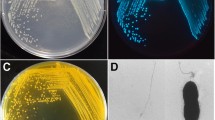Abstract
Two urease-positiveVibrio spp. were isolated from a brown shark (Carcharhinus plumbeus) that died in captivity at a national aquarium. Morphological, biochemical, and molecular genetic studies revealed one of the isolates to beV. damsela; the other isolate was unique and has been classified asV. carchariae sp. nov. BothV. damsela andV. carchariae were found to be virulent for spiny dogfish (Squalus acanthias), causing death in less than 18 hours after intraperitoneal injection of ca. 4×106 cells.V. damsela was strongly cytotoxic for Y1 adrenal cell monolayers;V. carchariae exhibited weak cytotoxicity for Y1 cells.V. damsela contained cryptic plasmids and both isolates were urease positive.V. carchariae was able to utilize urea as sole source of carbon and nitrogen.
Similar content being viewed by others
References
Barua D, Burrows W (1974) Cholera. W. B. Saunders Co., Philadelphia
Billy C (1965) Étude dùne bactérie alginolytique anaérobie:Clostridium alginolyticum n. sp. Ann. Inst. Pasteur 109:147–151
Blake PA, Weaver RE, Hollis DG (1980) Diseases of humans (other than cholera) caused by vibrios. Ann Rev Microbiol 34:341–367
Boylan JW (1967) Gill permeability inSqualus acanthias. In: Gilbert PW, Mathewson RF, Rall DP (eds) Sharks, skates, and rays. The Johns Hopkins Press, Baltimore, pp 197–206
Colwell RR, Liston J (1960) Microbiology of shellfish. Bacteriological study of the natural flora of Pacific oysters (Crassostrea gigas). Appl Microbiol 8:104–109
Colwell RR, Liston J (1962) The natural flora of certain marine invertebrates. J Insect Pathol 4:23–33
Cowan ST (1974) Cowan and Steel's manual for the identification of medical bacteria, 2nd ed. University Press, Cambridge
Furniss AL, Lee JV, Donovan TJ (1978) The vibrios. Public Health Laboratory Service, Monograph Series 11, Her Majesty's Stationery Office, London
Gillespie D, Spiegelman S (1965) A quantitative assay for DNA-RNA hybrids with DNA immobilized on a membrane. J Molec Biol 12:829–842
Guerinot ML, West PA, Lee JV, Colwell RR (1982)Vibrio diazotrophicus sp. nov., a marine nitrogen-fixing bacterium. Int J Syst Bacteriol 32:350–357
Hada HS, West PA, Lee JV, Stemmler J, Colwell RR (1984)Vibrio tubiashii sp. nov., a pathogen of bivalve mollusks. Int J Syst Bacteriol 34:1–4
Hatai K, Yasumoto S, Yasunaga N (1981) OnVibrio strains isolated from cultured Japanese horse mackerel (Trachurus japonicus). Fish Pathol 16:111–118
Huq A, Small EB, West PA, Huq MI, Rahman R, Colwell RR (1983) Ecological relationships betweenVibrio cholerae and planktonic crustacean copepods. Appl Environ Microbiol 45:275–283
Kado CI, Liu S-T (1981) Rapid procedure for detection and isolation of large and small plasmids. J Bacteriol 145:1365–1373
Kovacs N (1956) Identification ofPseudomonas pyocyanea by oxidase reaction. Nature 178:703
Krantz GE, Colwell RR, Lovelace E (1969)Vibrio parahaemolyticus from the blue crabCallinectes sapidus in Chesapeake Bay. Science 164:1286–1287
Lam S, Yeo M (1980) Urease-positiveVibrio parahaemolyticus strain. J Clin Microbiol 12:57–59
Love M, Teebken-Fisher D, Hose JE, Farmer III JJ, Hickman FW, Fanning GR (1981)Vibrio damsela, a marine bacterium, causes skin ulcers on the damselfish,Chromis punctipinnis. Science 214:1139–1140
MacDonell MT, Singleton FL, Roszak DB, Hood MA, Tison DL, Seidler RJ (1983) Rapid GC mol% screening of primary culture lysates using horizontal slab gel electrophoresis. J Microbiol Meth 1:81–88
Mach PA, Grimes DJ (1982) R-plasmid transfer in a wastewater plant. Appl Environ Microbiol 44:1395–1403
Mandel M (1970) Correlation of melting temperature and cesium chloride buoyant density of bacterial deoxyribonueleic acid. J Bacteriol 101:333–338
Maneval D, Colwell RR, Joseph SW, Grays R, Donta ST (1980) A tissue culture method for the detection of bacterial enterotoxins. J Tissue Culture Meth 6:85–90
Marmur J (1961) A procedure for the isolation of deoxyribonucleic acid from micro-organisms. J Molec Biol 3:208–218
May EB, Grimes DJ, Jones RT, Stemmler J, Hetrick FM, Colwell RR (1983) AVibrio infection in brown sharks (Carcharhinus plumbeus): clinical gross pathology and histopathology, presented at the 14th Annual Symposium of the International Association for Aquarium Animal Medicine, Long Beach, CA
Mayfield CI, Inniss WE (1977) A rapid, simple method for staining bacterial flagella. Can J Microbiol 23:1311–1313
Nealson KH (1978) Isolation, identification and manipulation of luminous bacteria. Methods Enzymol 57:153–166
Rigby PWJ, Dieckmann M, Rhodes C, Berg P (1977) Labelling deoxyribonucleic acid to high specific activity in vitro by nick translation with DNA polymerase. I. J Molec Biol 113:237–251
Schmidt U, Chmel H, Cobbs C (1979)Vibrio alginolyticus infections in humans. J Clin Microbiol 10:666–668
Thornley MJ (1960) The differentiation ofPseudomonas from other gram-negative bacteria on the basis of arginine metabolism. J Appl Bacteriol 23:37–52
Toranzo AE, Barja JL, Potter SA, Colwell RR, Hetrick FM, Crosa JH (1983) Molecular factors associated with virulence of marine vibrios isolated from striped bass in Chesapeake Bay. Infect Immun 39:1220–1227
Tubiash HS, Colwell RR, Sakazaki R (1970) Marine vibrios associated with bacillary necrosis, a disease of larval and juvenile bivalve mollusks. J Bacteriol 103:272–273
West PA, Colwell RR (1984) Identification and classification ofVibrionaceae-an overview. In: Colwell RR (ed) Vibrios in the environment, John Wiley & Sons, New York, pp 285–364
Author information
Authors and Affiliations
Rights and permissions
About this article
Cite this article
Grimes, D.J., Stemmler, J., Hada, H. et al. Vibrio species associated with mortality of sharks held in captivity. Microb Ecol 10, 271–282 (1984). https://doi.org/10.1007/BF02010940
Issue Date:
DOI: https://doi.org/10.1007/BF02010940




